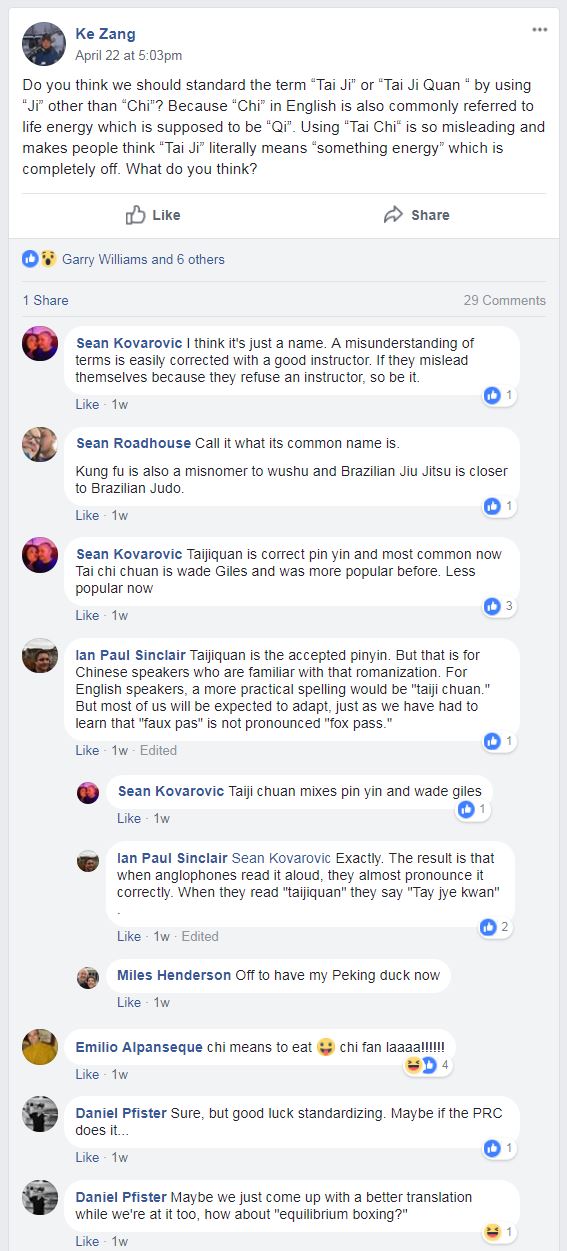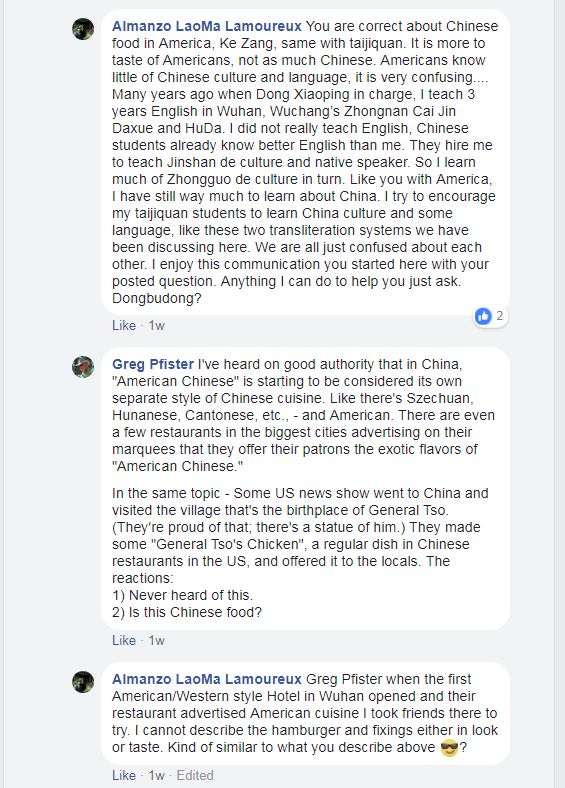As stated so eloquently below, “Begin where you are and invest the time that you have. The better the quality of your practice, the greater the return on your investment of time and energy. “
Ben Lo event this weekend (Nov 8th) in DC/VA/MD area: Wuwei T'ai Chi for announcing the November 10, 2018, 10 a.m. - 12:30 p.m. gathering honoring Master Ben Lo, starting at the Cabin John Park taijiquan court, and followed by lunch at a local restaurant.
Written by Russ Mason
Dear Friends,
As has been noted on this forum, the great Lo Pang-jeng, known in the West as "Benjamin P. J. Lo", passed away peacefully in his home surrounded by long-time students and family on October 12th. Lo Laoshi was the first person to study with Professor Cheng Man-ch'ing after his relocation to Taiwan in 1949. In spite of his eventual and very impressive achievement in T'ai-chi Ch'uan, he first came to Professor Cheng for medical treatment, not for martial arts instruction. Due to Ben's serious physical illness, Professor Cheng advised him to take up the practice of T'ai-chi so that his body could gain enough strength to derive benefit from the herbal remedies that had been prescribed. Ben was not aware of the fact that Professor Cheng had been a martial arts master of great renown on the Mainland, and he was quite surprised to hear that his doctor would prescribe the art, much less offer to teach it. He asked somewhat incredulously, "You know T'ai-chi? " Professor responded in simplicity and in sincere humility, "Enough to teach you."
With that, the young Ben Lo began his arduous course of study. Professor Cheng taught him in the traditional way. Ben was shown the first posture and instructed to "hold the posture" and relax...without moving...for one hour. Ben was not shown another posture until he could demonstrate the previous one to Professor' s satisfaction and hold it without moving and in accordance with the principles of T'ai-chi for one hour. When he had gotten as far as the posture Lifting Hands (T'i Shou), he stood in his teacher' s presence for a total of 120 hours holding that one posture. But Professor would not show him the next movement. He was only able to progress beyond this point in the form due to the intercession of Madame Cheng, who implored her husband in Ben's behalf. She said, "You cannot teach him so strictly as Master Yang taught you. Times are changing!" Professor' s response was, "Why should I show him another posture when he can't yet do this one properly. His leg is shaking like a pipa string!"
Still, gradually, Ben made progress. Mr. Lo told me that for several years he only went three places: home, school, and Professor' s house. He would go to Professor Cheng's and practice for one hour in the morning and back again after school for one more hour of practice in the afternoon. Then he would go home and in his personal time "practice T'ai-chi" . He said that other young people his age, such as his school mates, went to social gatherings, saw movies, and so forth. Not Ben. He only attended to his school work and practiced T'ai-chi. In the beginning, his motivation was to save his life and regain his health. Later, he learned not to fear suffering but, rather, to invest in loss and to "eat bitter" . And as Ben endured the bitter training, not only did his health improve, but his gong-fu grew deeper and more profound.
Ben eventually learned of his teacher' s fame, as many famous boxers came to visit and to pay their respects. Some came to test Professor Cheng's ability. In these cases, they had to first face Ben Lo. Few passed this initial test. As Mr. Robert W. Smith put it, "Ben was discouraging. " Yet, as his skill and reputation increased, he demonstrated that he had learned the lessons of wude as well as wushu. It is unusual in the world of martial arts for a person's substance to exceed his or her fame, but this is true of Mr. Lo. Although he is known and respected around the world, Mr. Lo remained sincerely humble and never demonstrated his skills just for the sake of showing off. When his close students asked why he didn't demonstrate more of his amazing abilities in public, Ben simply said, "Why use a quarter when a nickel will do." Mr.. Robert W. Smith referred to Mr. Lo in this way: "Modest man; true T'ai-chi. "
I met Mr. Lo almost 40 years ago. Although he was my T'ai-chi "uncle" and not my primary teacher, he influenced my life and practice profoundly. I am deeply grateful for his kindness, his example, his instruction, and his patient and persistent correction. He inspired me again and again over the last four decades to continue practicing T'ai-chi, especially when my perseverance was wavering. He challenged me to deepen my practice when it's quality was found wanting, reminding me of the old Chinese saying, "Buy the best and cry once." When I lamented over all of the time I had lost by not practicing as diligently and correctly as I should have, he looked me in the eye and said, "Go ahead and cry. Then, dry your eyes and commit yourself to practice. Begin where you are and invest the time that you have. The better the quality of your practice, the greater the return on your investment of time and energy." I have never trained so diligently as when I was under Mr. Lo's watchful eye.
In addition to setting a high standard of practice in the West and blessing us with excellent instruction, Lo Laoshi also contributed to our T'ai-chi community in other ways. In particular, we must thank him for his excellent translations of several key texts: Professor Cheng's masterpiece (Cheng Tzu's Thirteen Treatises on T'ai Chi Ch'uan, North Atlantic, 1985), the T'ai-chi Classics (The Essence of T'ai Chi Ch'uan: The Literary Tradition, 1979, revised in 2008, IRI Press), and Chen Wei-ming' s T'ai Chi Ch'uan Ta Wen (Questions and Answers on T'ai Chi Ch'uan, North Atlantic,1985) .
For more information on Ben Lo, please see the excellent article by Larry Mann and Don Davis, "Conservator of the Classics: An Interview with Benjamin Pang-jeng Lo", published in the Journal of Asian Martial Arts, Volume 5, No. 4, pp. 46-67 and reprinted in the anthology entitled Cheng Man-ch'ing and T'ai Chi: Echos in the Hall of Happiness, Via Media Publishing, 2015.
See also the comments of Mr. Robert W. Smith on Ben Lo, particularly in his final book, Martial Musings: A Portrayal of Martial Arts in the 20th Century, Via Media Publishing, 1999, pp. 294-303, etc..
I also had the honor of working with Mr. Lo on his articles memorializing his classmates and friends Robert W. Smith and Liu Hsi-heng. The first, entitled "In Memory of our American Tai Chi brother, Robert W. Smith", was published in T'ai Chi, Marvin Smalheiser&# 39;s quarterly magazine, Volume 37, No. 1, Spring 2013, pp. 6-9. The second, "Liu Hsi-heng: Memories of a Taiji Sage", was first published in the Journal of Asian Martial Arts, Volume 19, No. 2, pp. 72-107, and it was subsequently included in the anthology entitled Cheng Man-ch'ing and T'ai Chi: Echos in the Hall of Happiness, Via Media Publishing, 2015.
Moreover, Martin Inn, of the Inner Research Institute, compiled and published DVDs of Mr. Lo's lectures on the T'ai Chi Classics (The Lectures, with Benjamin Pang Jeng Lo: Commentaries on The Essence of T'ai Chi Ch'uan, IRI Press, 2010). He also persuaded Ben to allow him to publish invaluable footage of Mr. Lo demonstrating the solo exercise and double-edged sword forms (Benjamin Pang Jeng Lo: Enduring Legacy of Professor Cheng Man Ch'ing, IRI Press, 2016). These are priceless treasures for all who study the art of T'ai-chi Ch'uan.
Those of us who knew him will never forget him. May he rest in peace, and may his memory be honored with deepest respect.
Sincerely,
Russ Mason
*Taken from the Facebook Page Taiijquan “One Family” Mission. Posted by Matt Stampe on Nov 8th, 2018.





































